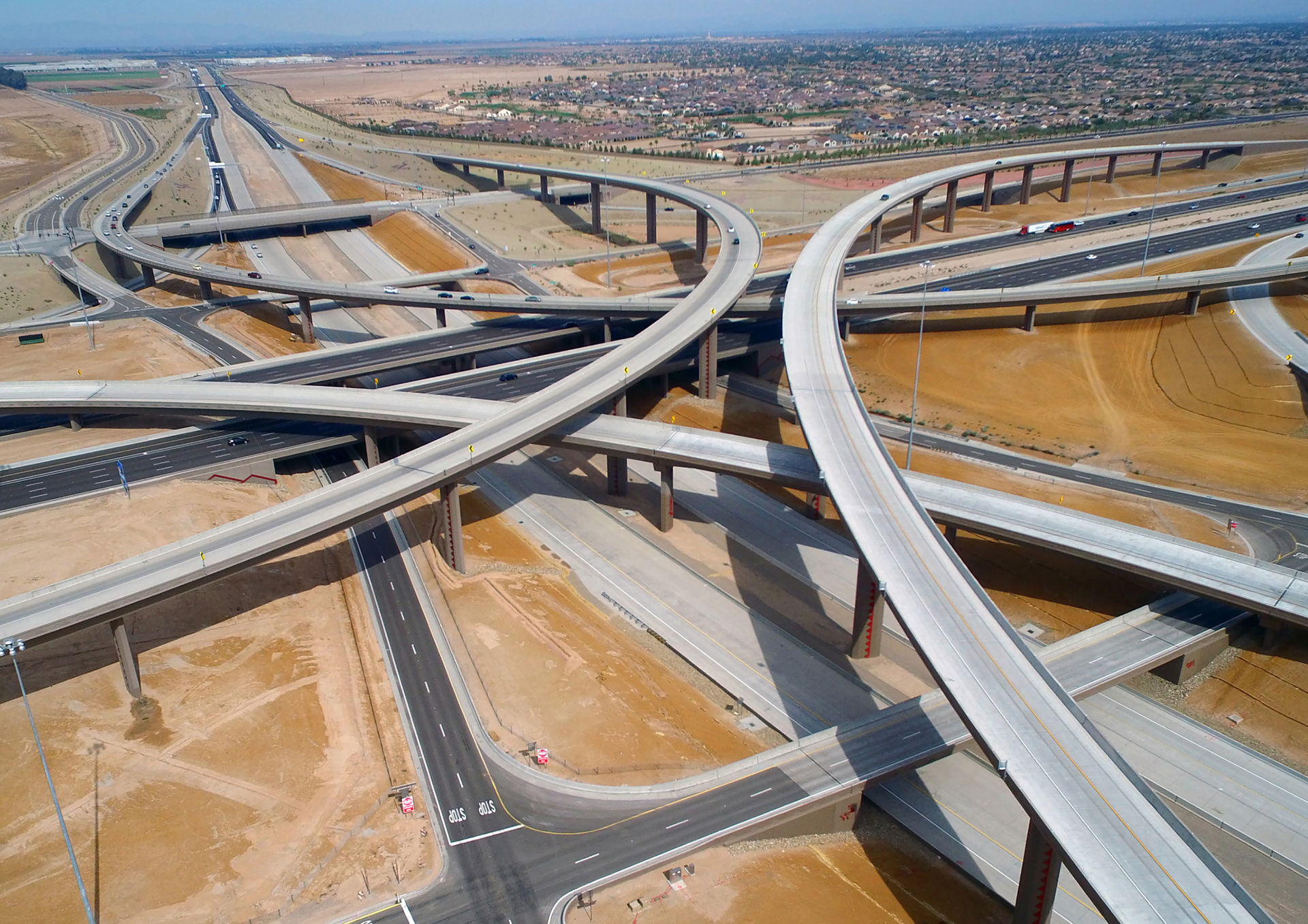Ribbons of concrete and asphalt crisscross Arizona to form the freeways that connect the state’s residents to regional neighbors and the world at large. These corridors facilitate the flow of people and goods that are the hallmarks of daily life. Highway infrastructure is where the rubber meets the road for economic development.
“A well-planned transportation system, including freeways and highways as well as arterial streets, is key to mobility,” says Eric Anderson, executive director for the Maricopa Association of Governments (MAG). “An efficient transportation system drives down cost, either your personal cost in terms of commuting or the cost of shipping and receiving goods for the manufacturing process.”
Maricopa County has an impressive track record of investing in its roads. In 1985, voters approved Proposition 300, which was one of the first dedicated transportation taxes in the country. Funds from the initiative were responsible for the construction of the Loops 101 and 202.
READ ALSO: Loop 303 corridor becomes global center for development
“Proposition 300 was limited to new freeway construction,” Anderson explains. “But we need to invest in our existing highways, too. Proposition 400 passed in 2004, which not only funded new freeways like the Loop 303 and South Mountain Freeway, but it also allowed for significant improvements to the existing highway infrastructure.”
When a business is weighing whether to move to a particular location, several factors are considered, including the efficacy of the freeway network.
“Big manufacturers want to be within a few miles of an interstate or highway. Depending on their truck traffic and employment counts, it’s an integral part of what they need to know throughout the site selection process,” comments Jackob Andersen, president and CEO of Saint Holdings.
The Valley’s proximity to the ports of Los Angeles, where many goods are imported and exported, makes it an attractive location for manufacturers and distributors. Anderson, of MAG, notes that 86% of companies with more than 250 employees in metro Phoenix are within 2 miles of a freeway or the light rail.
“In terms of efficiency, we’ve got access to Mexico, and you can reach Colorado, New Mexico, Nevada, California and Utah all reasonably easily on good road networks,” Andersen continues. “The value is noticeable by virtue of what’s happening in the industrial world in Greater Phoenix.”
Arizona, especially the Valley area, is cementing its reputation as a destination for industry in part because of the continued investments in the state’s transportation system. Here’s a look at how pavement keeps the state’s economic engine humming.
Loop 303 and Interstate 17
Stretching from the northern reaches of the Valley to its southwest region, the Loop 303 has been a magnet for industrial development. One of the first developments to attract major investments was PV|303 in Goodyear. Major companies like REI, Ball Corporation and Dick’s Sporting Goods proved that the area is a viable location for business, according to Randy Huggins, economic development officer for Glendale.
“A big portion of what convinced those companies to come was access to labor,” Huggins says. “That’s the story that’s driven the West Valley; you have this connectivity of the freeway system and the labor pool that already lives in the area, which reduces commute time and increases quality of life.”
Brian Friedman, director of economic development for Glendale, notes that the Maricopa County market not only services the 5 million residents who live within its borders, but also the 30 million people who live in Southern California. “Maricopa County can be seen as East Los Angeles because a truck is capable of leaving Downtown Phoenix and reaching all of the L.A. Basin and San Diego area in a single day,” he remarks.
Huggins adds that the majority of the 14 million square feet under development in Glendale is within a half mile of the Loop 303 or Northern Parkway, including a 1.25-million-square-foot Walmart facility and a 1.25-million-square-foot structure leased to MLILY, a mattress manufacturer.
Further north along the Loop 303 near Interstate 17, Taiwan Semiconductor Manufacturing Company (TSMC) is building a $12 billion chip plant that is estimated to bring 1,600 jobs to Greater Phoenix. Interstate 17, another critical highway for Arizona’s economy, is undergoing an expansion north of Phoenix that will help alleviate the traffic that is a persistent problem during weekends and will be a boon for Arizona’s tourism industry.
According to Anderson, the TSMC project would not have happened without the investments in the Loop 303 and Interstate 17. “It wasn’t the only factor that caused them to choose that location, but it was a major one,” he says.
Heather Maxwell, executive director of the Anthem Area Chamber of Commerce, describes the Loop 303 as a gamechanger for access to the communities in far north Phoenix.
“Having a commuter route from the West Valley to reach these large companies up here around the Loop 303 is crucial to the North Valley, not to mention for the development currently being brought in with the TSMC plant and the supporting businesses that will follow,” she says.
Northern Parkway and SR30
Near the border of Glendale, Peoria and El Mirage, Northern Parkway allows for quick east-west travel across the West Valley. At full buildout, the corridor will span 12.5 miles, from the US60 to the Loop 303. Since the area is near Luke Air Force Base, no new residential construction is allowed, meaning it’s a prime site for industrial development.
“As soon as Northern Parkway was built, the land on either side of it was annexed and zoned into Glendale,” Huggins explains. “By zoned, I mean we went through the process of creating entitlements to attract companies such as Red Bull, White Claw and Cold Summit.”
One of the key components of the success of Northen Parkway, Huggins contends, is that there is rail accessibility. Not only can large trucks navigate the area easily, but raw materials can be brought in by train.
“Ball brings in raw aluminum and converts it into a can. A skybridge connects the Ball factory to Red Bull’s facility, which fills the can. The filled can crosses another skybridge to the Red Bull North America Distribution Center,” Huggins says. “All three of those buildings use rail in different parts of their business, along with trucking for shipping materials and finished goods.”
Further south, another east-west corridor is underway: SR30, also known as the Tres Rios Freeway. Anderson explains that SR30 will be south of Interstate 10 and run parallel to it, acting as a much-needed reliever route. Eventually, the freeway will stretch between the Durango Curve on the Interstate 17 to SR85 in Buckeye.
“There are three different sections to the project. We’re working on the extension of our sales tax in Maricopa County. Assuming it passes, construction on the center section will start soon, which runs from the South Mountain Freeway to where the Loop 303 will connect,” Anderson notes. “It’s really important we continue making these investments.
Loop 202 expansion and SR24
Until SR30 is built, the primary Interstate 10 reliever route is the Loop 202 expansion, also known as the South Mountain Freeway. The new development allows eastbound traffic to bypass Downtown Phoenix and avoid the congestion caused by the interchanges.
The new freeway changes the landscape for labor markets. “It provides a link between the Southeast Valley and the Southwest Valley. Much of the high-tech employment and labor force is in the Southeast Valley,” Anderson says. “Now, if a high-tech company wants to locate in the Laveen area, they can look to the Southeast Valley for a labor force. Long term, we think that it will create better jobs in the West Valley and reduce commute times.”
Bill Jabjiniak, director of economic development for Mesa, says that the South Mountain Freeway has been well received.
“The effects are still playing out in front of us, but the Loop 202 expansion has had a positive effect on Mesa and the East Valley in general. It’s allowed businesses to locate here that need trucking and freight access to the Southern California marketplace, especially when time-to-market is a critical part of the business model,” he comments.
Prior to the freeway’s opening, businesses who wanted to serve the Los Angeles market typically chose the West Valley to avoid the traffic in Phoenix.
“Now that you can get around so much easier, companies aren’t hesitating,” Jabjiniak notes. “A great example is the 460,00-square-foot Dexcom Distribution Center. The company builds medical devices in Mesa, but they also use this distribution center in southeast Mesa that’s right next to the Loop 202.” It is also near SR24, another new addition to Mesa’s transportation system.
“State Route 24 is opening up new areas to industrial development,” Jabjiniak contends. “We have fresh industrial land where the semiconductor industry is looking to expand. We’re actually seeing supply chain from TSMC and Intel come to Southeast Mesa. We have existing industry like Matheson Tri-Gas and MCG Pure Chemicals America, and now you’ll see supply chain gather around them as well. State Route 24 access is huge for us, and it makes it easier to attract large and internationally known employers.”
Anderson concludes, “There’s never enough money to do everything. It’s always a matter of finding the best project that will result in the most benefit. But I think we’ve done a good job in the region to identify key transportation corridors. We’re gearing up to ask the voters to renew the half-cent sales tax here in Maricopa County for transportation during the November 2022 election. We have to get authorization from the legislation, but the pitch is that we have to continue to make these kinds of investments because we’re going to continue to grow.”




